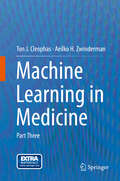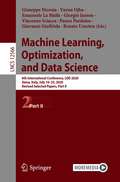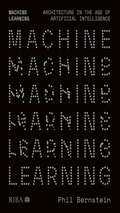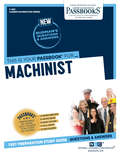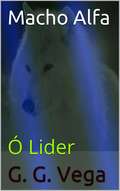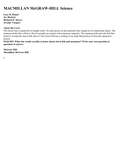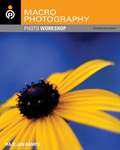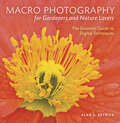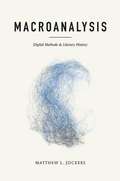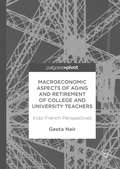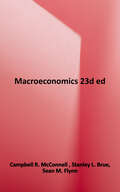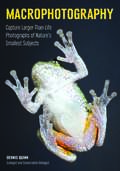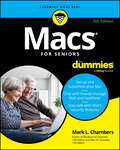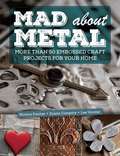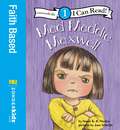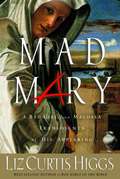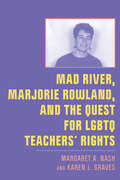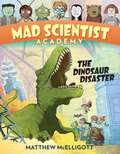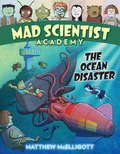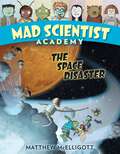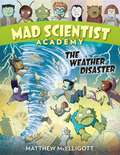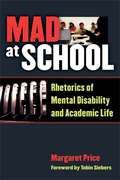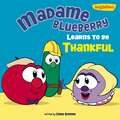- Table View
- List View
Machine Learning in Medicine
by Aeilko H. Zwinderman Ton J. CleophasMachine learning is a novel discipline concerned with the analysis of large and multiple variables data. It involves computationally intensive methods, like factor analysis, cluster analysis, and discriminant analysis. It is currently mainly the domain of computer scientists, and is already commonly used in social sciences, marketing research, operational research and applied sciences. It is virtually unused in clinical research. This is probably due to the traditional belief of clinicians in clinical trials where multiple variables are equally balanced by the randomization process and are not further taken into account. In contrast, modern computer data files often involve hundreds of variables like genes and other laboratory values, and computationally intensive methods are required. This book was written as a hand-hold presentation accessible to clinicians, and as a must-read publication for those new to the methods.
Machine Learning, Optimization, and Data Science: 6th International Conference, LOD 2020, Siena, Italy, July 19–23, 2020, Revised Selected Papers, Part II (Lecture Notes in Computer Science #12566)
by Panos Pardalos Giuseppe Nicosia Giovanni Giuffrida Renato Umeton Vincenzo Sciacca Varun Ojha Emanuele La Malfa Giorgio JansenThis two-volume set, LNCS 12565 and 12566, constitutes the refereed proceedings of the 6th International Conference on Machine Learning, Optimization, and Data Science, LOD 2020, held in Siena, Italy, in July 2020. The total of 116 full papers presented in this two-volume post-conference proceedings set was carefully reviewed and selected from 209 submissions. These research articles were written by leading scientists in the fields of machine learning, artificial intelligence, reinforcement learning, computational optimization, and data science presenting a substantial array of ideas, technologies, algorithms, methods, and applications.
Machine Learning: Architecture in the age of Artificial Intelligence
by Phil Bernstein‘The advent of machine learning-based AI systems demands that our industry does not just share toys, but builds a new sandbox in which to play with them.’ - Phil Bernstein The profession is changing. A new era is rapidly approaching when computers will not merely be instruments for data creation, manipulation and management, but, empowered by artificial intelligence, they will become agents of design themselves. Architects need a strategy for facing the opportunities and threats of these emergent capabilities or risk being left behind. Architecture’s best-known technologist, Phil Bernstein, provides that strategy. Divided into three key sections – Process, Relationships and Results – Machine Learning lays out an approach for anticipating, understanding and managing a world in which computers often augment, but may well also supplant, knowledge workers like architects. Armed with this insight, practices can take full advantage of the new technologies to future-proof their business. Features chapters on: Professionalism Tools and technologies Laws, policy and risk Delivery, means and methods Creating, consuming and curating data Value propositions and business models.
Machinist: Passbooks Study Guide (Career Examination Series #C-1414)
by National Learning CorporationThe Machinist Passbook® prepares you for your test by allowing you to take practice exams in the subjects you need to study. It provides hundreds of questions and answers in the areas that will likely be covered on your upcoming exam, including but not limited to: operation and maintenance of all machine shop equipment; hand tools and machine shop practices; machinery components; measuring devices and instruments; metals and heat treatment; reading comprehension and plan reading; related machine shop mathematics; safety; supervision and reports; and other related areas.
Macho Alfa
by Guido Galeano Vega Eunice T AndreLivro que trata de aspectos sociais e culturais de líderes em grupos animais e humanos. Macho Alfa Este conceito é mais bem aplicado no âmbito da natureza ou no sistema biológico animal. Nas sociedades modernas, é aplicado também para definir certo tipo de pessoas, que se caracterizam por sua capacidade de liderança. Como o conceito tem uma relação mais direta com o mundo animal, e mais ainda vinculado a certas espécies de predadores, implacáveis, de extrema eficiência no processo de caçada grupal, atividade motivada para garantir ou melhorar a possibilidade de sobrevivência em contextos de natureza selvagem, como é o caso dos lobos. Ele tem sido aplicado também nos grupos humanos com um estilo de vida de características similares.
Macmillan McGraw Hill Science
by Lucy H. DanielMacmillan/McGraw-Hill Science employs a unique lesson plan to develop science concepts three ways: through purposeful, hands-on activities; compelling reading content; and dynamic visuals and graphics. Key partnerships include Sally Ride Science and TIME For Kids.
Macro Photography Photo Workshop
by Haje Jan KampsSpecial techniques for creating unique, artistic, close-up images Macro, or close-up, photography is gaining popularity, and this book covers all of the challenges associated with taking great close-ups: depth of field, focus, and exposure. Copublished with Photoworkshop. com, a leading online educational resource for both beginning and professional photographers, this task-oriented reference allows readers to learn by doing and offers outstanding examples and instructions.
Macro Photography for Gardeners and Nature Lovers: The Essential Guide to Digital Techniques
by Alan L. DetrickGardeners and nature lovers delight in taking pictures—especially close-ups of flowers, butterflies, and insects. And though advances in digital camera technology have made taking, storing, and sharing photos easier than ever, taking top-quality pictures requires familiarity with both digital technology and the general principles of photography. Macro Photography for Gardeners and Nature Lovers provides exactly the information that aspiring photographers—no matter their level of skill—need to take their photos to the next level. Clear and concise chapters cover the basics of macro (close-up) photography, explain the features of current digital single-lens reflex cameras, show the many ways images can be composed, and share tips on digital effects, storage, and manipulation of imagery. Throughout the text, helpful tips, definitions, exercises, and case studies serve to demystify digital photography. Each lesson is supported by examples of the author's stunning photography. Whether taking photos of flowers and insects, compiling a photographic record of your garden, or simply sharing beautiful images with friends and family, everyone can become accomplished photographers of the world's small-scale wonders.
Macroanalysis: Digital Methods and Literary History
by Matthew L. JockersIn this volume, Matthew L. Jockers introduces readers to large-scale literary computing and the revolutionary potential of macroanalysis--a new approach to the study of the literary record designed for probing the digital-textual world as it exists today, in digital form and in large quantities. Using computational analysis to retrieve key words, phrases, and linguistic patterns across thousands of texts in digital libraries, researchers can draw conclusions based on quantifiable evidence regarding how literary trends are employed over time, across periods, within regions, or within demographic groups, as well as how cultural, historical, and societal linkages may bind individual authors, texts, and genres into an aggregate literary culture. Moving beyond the limitations of literary interpretation based on the "close-reading" of individual works, Jockers describes how this new method of studying large collections of digital material can help us to better understand and contextualize the individual works within those collections.
Macroeconomic Aspects of Aging and Retirement of College and University Teachers: Indo-French Perspectives
by Geeta NairThis book explores the universal and highly topical issues of ageing and retirement. It places a particular focus on the macroeconomic aspects of the ageing and retirement of college and university teachers, through a case study of teachers and professors in France and India. While the ageing of the population and the financing of the pension system are notoriously pressing issues in Western nations such as France, it has previously not been acknowledged that these issues are also critical to the development trajectory of emerging countries such as India. The book also highlights the importance of pensions for welfare, well-being and stability in all categories of workers, including workers in the informal sector and private companies devoid of pension schemes, where jobs are largely irregular and temporary in nature. It will be of great interest to researchers in the fields of comparative education, sociology and economics.
Macroeconomics, 23rd Edition
by Stanley L. Brue Sean M. Flynn Campbell R. McConnellMaximize your results effortlessly. Experience unparalleled outcomes with McConnell/Brue/Flynn – a streamlined solution for elevating your success. When presented with the choice to work harder or smarter, this product empowers you to choose the latter. Revolutionize your approach to economics education with a contemporary learning tool that simplifies both teaching and learning. Macroeconomics provides a cutting-edge experience for instructors and students, offering real-life examples and advanced digital resources. Dive into interactive, immersive, and adaptive learning assignments, creating a student-centric environment that transforms the way subjects are presented. For instructors, our comprehensive teaching package takes care of the heavy lifting, allowing you to concentrate on what you love.
Macroeconomics, 6th Custom Edition for Temple University
by Michael ParkinMacroeconomics seeks to put clarity and understanding in the grasp of the student with a careful and vivid exploration of the tension between self-interest and the social interest, the role and power of incentives--of opportunity cost and marginal benefit--and demonstrating the possibility that markets supplemented by other mechanisms might allocate resources efficiently. Parkin students begin to think about issues the way real economists do and learn how to explore difficult policy problems and make more informed decisions in their own economic lives.
Macrophotography
by Dennis QuinnMacrophotography allows for the capture of small photographic subjects in life size or larger magnification, allowing viewers to experience the world around them in a way that is simple not possible with the naked eye. With a magnified view, we can see the distinctive make-up of an insect, animal, or flower--its texture, details, and subject features that we might otherwise be completely unaware of. In this unique book, Dennis Quin turns his macro lenses upon the natural world and teaches readers to choose and use the tools they need to capture magical images of all manner of bugs, flowers, reptiles, and more. In each of the 60 sections in this beautifully illustrated book, Quin details the tricks of the trade. You’ll learn where to find your subjects, how to make sure that the background adds to the overall impact of the image, how to track insects in flight, and other skills that will increase your odds of capturing technically strong, visually rewarding shots. In each section, you’ll see 1 to 3 images of a unique subject and will get detailed instruction as to how Quin shot the image--including the equipment used, settings chosen, the camera angle, and more. There’s more to this book than instructional photographic text. In each of the 60 discrete sections, Quin provides fascinating tidbits about each animate object--describing the life cycle, feeding habits, mating rituals, breeding, and much more--or characteristics of botanical subjects. This book provides an inspiring and enlightening blend of photographic technique and fascinating science lessons. It is perfect for serious amateur photographers, wildlife/landscape photography enthusiasts, and even those whose "bread and butter” shots are in another genre completely. The book is sure to impress.
Macs All-in-One For Dummies
by Paul McFedriesThe huge reference guide you need to use the full power of your Mac Macs All-in-One For Dummies truly covers it all. This complete reference guide contains five books in one, so you can learn all your Mac is capable of. You’ll get a complete understanding of your computer, so you can use it for pleasure or business, become a multimedia master, surf the web like a pro, troubleshoot problems as they arise, and so much besides. This latest edition is updated for the newest version of macOS, the hottest apps, and the just-released Macs. Running an older Mac? Don’t worry, this book won’t leave you behind. Everything you need to do on your Mac can be learned with the help of Macs All-in-One For Dummies. Learn your way around your Mac and customize all the macOS features Discover the newest features (and the returning classics) so you can make the most of your machine Beef up your security, stay safe while surfing the web, and figure it out when things go wrong Use your computer to work, play, create videos, keep in touch, and everything else Computer users who are switching to a Mac for the first time, as well as previous Mac users who are upgrading to the newest model, need a guide for getting the most out of their powerful computer. This is that guide.
Macs For Seniors For Dummies
by Mark L. ChambersIt's never too late to become a Mac expert! Every year, hundreds of thousands of seniors choose to use Mac products—like the MacBook Air and iMac—to connect with their loved ones, access the web, and make their lives easier. And even if you've never used a Mac before, we're here to show you how you can make the most of it—one easy step at a time! The newly updated fifth edition of Macs For Seniors For Dummies is filled with large, easy-to-read text, sharp figures and illustrations, and accessible instructions to help you give the Gen-Z or millennial in your life a run for their money. You'll learn how to customize your Mac so it works exactly the way you want it to, connect to the Internet, work with documents and spreadsheets, play music, watch video, and even read the latest news headlines. This book walks you through how to secure your Mac so your privacy and data is protected and gets you comfortable with the operating system so you won't have to worry about “breaking” something again. You'll also find: Instructions for handy applications so you can make to-do lists and text documents Step-by-step instructions to keep your Mac updated for security and convenience Strategies to help you choose a Mac to buy (if you haven't bought one already) Macs are truly the computers for everyone! Whether you're looking to get started with Macs for the first time or you're a long-time Mac user searching for updates, Macs For Seniors For Dummies is where you'll find the easy-to-follow info you need. Grab a copy today!
Mad About Metal: More Than 50 Embossed Craft Projects for Your Home
by Monica Fischer Susan CumpstyCraft metal has endless decorative possibilities. It is pliable and can be wrapped around or adhered to any surface you can imagine. This book is all about using colored craft metal? decorating it by means of embossing, cutting out designs, adding further color, taking away color and filling in 3D designs, and much more?to customize found objects for your home. You will learn more about the metal and supporting mediums, as well as how to use the tools and familiarize yourself with several techniques?all of which can be applied in making more than fifty decorative and functional items provided in this book. The original projects were designed and created specifically to showcase a variety of techniques and applications, including: Transferring and tracing designs Creating texture by means of inexpensive handheld tools or manual processes Using an embossing machine such as the cuttlebug? for textures, patterns and die-cuts Finishing techniques such as sanding, ageing and painting Upcycling and repurposing Tips and tricks to simplify processes The projects range from beginner to advanced levels and from quick ideas to masterpieces that will take longer to complete. Magnificent photographs of the finished objects will inspire you while step-by-step instructions and photographs will help you to get started right away.
Mad Maddie Maxwell: Biblical Values, Level 1 (I Can Read! #Level 1)
by Stacie K.B. MaslynMaddie’s jump rope is missing. When she doesn’t find it in all the usual places, she gets angry. She blames each member of her family in turn. Through familiar rhyme and repetition, simple text, and delightful illustrations, this level-one I Can Read Book provides support for the earliest readers.
Mad Mary: A Bad Girl from Magdala, Transformed at His Appearing
by Liz Curtis HiggsCome meet the genuine Mary Magdalene of the Bible -- not the scarlet-draped legend -- and follow her one-of-a-kind story of deliverance and dedication, despair and declaration. Like my previous "Bad Girls" books, "Mad Mary" begins with the fictional journey of Mary Margaret Delaney, a bad woman-or was it madwoman? -- adrift in contemporary Chicago, desperate for someone to save her from herself. Once Mary Delaney's story has prepared our hearts for learning, we'll leave the Windy City and go verse by verse through Mary of Magdala's ancient biblical tale, tossing aside modern misconceptions as we embrace the real Mary M. Prepare to be amazed by this eye-opening sister who was transformed twice when You-Know-Who showed up and spoke her name.
Mad River, Marjorie Rowland, and the Quest for LGBTQ Teachers’ Rights (New Directions in the History of Education)
by Margaret A. Nash Karen L. GravesMad River, Marjorie Rowland, and the Quest for LGBTQ Teachers’ Rights addresses an important legal case that set the stage for today’s LGBTQ civil rights–a case that almost no one has heard of. Marjorie Rowland v. Mad River School District involves an Ohio guidance counselor fired in 1974 for being bisexual. Rowland’s case made it to the U.S. Supreme Court, but the justices declined to consider it. In a spectacular published dissent, Justice Brennan laid out arguments for why the First and Fourteenth Amendments apply to bisexuals, gays, and lesbians. That dissent has been the foundation for LGBTQ civil rights advances since. In the first in-depth treatment of this foundational legal case, authors Margaret A. Nash and Karen L. Graves tell the story of that case and of Marjorie Rowland, the pioneer who fought for employment rights for LGBTQ educators and who paid a heavy price for that fight. It brings the story of LGBTQ educators’ rights to the present, including commentary on Bostock v Clayton County, the 2020 Supreme Court case that struck down employment discrimination against LGBT workers.
Mad Scientist Academy: The Dinosaur Disaster (Mad Scientist Academy #1)
by Matthew McElligottFans of Ada Twist, Scientist, will want to enroll in Dr. Cosmic's class of clever monsters at the Mad Scientist Academy as they solve the greatest challenges in science in this perfect blend of adventure and exploration. Welcome to Mad Scientist Academy! The first day of school is always exciting, and Dr. Cosmic&’s new students can&’t wait to get started. After their teacher reveals that their school pet, Oscar, is a dinosaur, they quickly realize Dr. Cosmic has an unusual teaching style. To find Oscar, the class has to follow the clues through the realistic dinosaur exhibit Dr. Cosmic designed and built over the summer. But when a malfunction causes the robotic dinosaurs to come alive, this prehistoric exhibit feels a little too real! &“Dr. Cosmic is plainly a colleague of Ms. Frizzle, and the mix of pithy banter, tumultuous field-trip mishaps, and science fact is as familiar as it is winning. Fans of the Frizz will be dino-delighted. Mad fun.&” —Kirkus Reviews, Starred &“Like Joanna Cole and Bruce Degen&’s &‘Magic School Bus&’ series (Scholastic), the use of a school setting, a quirky teacher, and wild hands-on learning situations provides an engaging blend of humor, adventure, and information.&” —School Library Journal &“One of Summer&’s Must-Read Children&’s Books.&” —Bookish.com Kids&’ Indie Next List
Mad Scientist Academy: The Ocean Disaster (Mad Scientist Academy)
by Matthew McElligottFans of Ada Twist, Scientist will want to join Dr. Cosmic's class of clever monsters as they explore the dark depths of the ocean in the fourth book of the Mad Scientist Academy series.The students in Dr. Cosmic's class take their lessons underwater when they're introduced to his latest invention, the SKWID--a special submarine that explores the ocean and looks like a real giant squid!With the guidance of oceanographer Professor Fathom, the class embarks on an exploration of the deep sea. Their next assignment? Identify the smallest producers and consumers of the ocean.But when a giant whale approaches the SKWID, mistaking it for an actual squid, the students must use their trusted scientific handbooks to find a way to escape the submarine and return to the undersea lab--before they become the whale's lunch!Don't miss more from the Mad Scientist Academy series!--The Dinosaur Disaster, The Weather Disaster, and The Space Disaster."Dr. Cosmic is plainly a colleague of Ms. Frizzle [of The Magic School Bus], and the mix of pithy banter, tumultuous field-trip mishaps, and science fact is as familiar as it is winning. Fans of the Frizz will be dino-delighted. Mad fun." --Kirkus Reviews, starred review of Mad Scientist Academy: The Dinosaur Disaster
Mad Scientist Academy: The Space Disaster (Mad Scientist Academy #3)
by Matthew McElligottFans of Ada Twist, Scientist, will want to join Dr. Cosmic&’s class of clever monsters as they tackle gravity, comets, and many moons in the third book of the Mad Scientist Academy series. When Dr. Cosmic&’s class meets Commander Nova, the school astronomer, they know their next lesson will be out of this world! With the help of Dr. Cosmic&’s latest invention—a planetarium—the class must complete four challenges. Each time the planetarium shifts and the atmosphere changes, the students find themselves floating from planet to planet. They put their new magnetic antigravity belts and trusted handbooks to the test to figure out where in the solar system Dr. Cosmic&’s invention has &“sent&” them—and how to land safely back on Earth.Don't Miss Mad Scientist Academy: The Ocean Disaster!"Young readers can only hope for this much excitement on their real field trips." —Kirkus Reviews"[A] space adventure that young readers will pore over, learn from, and enjoy." —School Library Journal
Mad Scientist Academy: The Weather Disaster (Mad Scientist Academy #2)
by Matthew McElligottFans of Ada Twist, Scientist, will want to join Dr. Cosmic&’s class of clever monsters as they face down snow, floods, and a dangerous thunderstorm when freak weather conditions threaten the school in the second book of the Mad Scientist Academy series. Dr. Cosmic can&’t wait to introduce the students to his latest invention, the CHAOS machine, designed to keep the school at the right temperature for learning. But when the machine starts to malfunction, causing extreme weather conditions, the students must use their upgraded handbooks to stop CHAOS before it destroys the entire school! Join Dr. Cosmic&’s clever class of monsters as they solve the greatest challenges in science, in this blend of adventure and exploration, perfect for Common Core and STEM."With outlandish situations rendering scientific concepts memorable, McElligott has concocted a winning formula for learning as entertainment."--Kirkus Reviews"Science fans and comics enthusiasts will dive right into this . . . There's enough fun here for anyone." —School Library Journal"Engaging and educational." —Booklist"No need for MSA kids to take a field trip: what could be more interesting than school?" —The Bulletin
Mad at School: Rhetorics of Mental Disability and Academic Life
by Margaret PriceMad at School explores the contested boundaries between disability, illness, and mental illness in the setting of U.S. higher education. Much of the research and teaching within disability studies assumes a disabled body but a rational and energetic (an 'agile') mind. In Mad at School, scholar and disabilities activist Margaret Price asks: How might our education practices change if we understood disability to incorporate the disabled mind?
Madame Blueberry Learns to Be Thankful / VeggieTales (Big Idea Books / VeggieTales)
by Cindy KenneyPresented in the 8x8 softcover format, complete with stickers for additional fun, VeggieTales’ Madame Blueberry Learns to Be Thankful helps little ones see how important it is to be thankful for what they have. When Madame Blueberry needs to begin rebuilding her tree house, her friends Bob and Larry come to help. But when they begin to talk about getting more and more things that might make the job easier, she reminds them that they should be happy with what they have.
